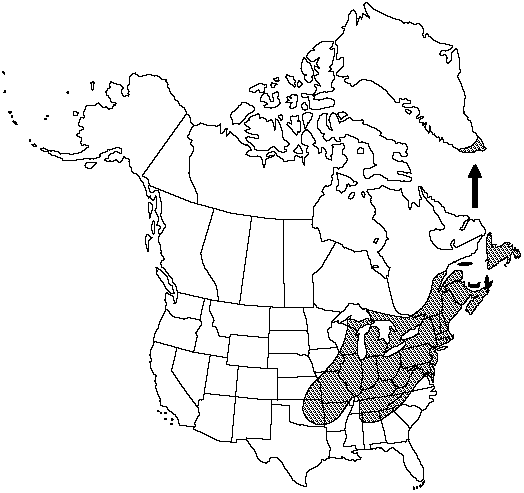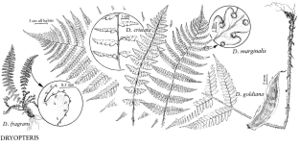Dryopteris marginalis
Manual 632. 1848.
Leaves monomorphic, green through winter, 30–100 × 10–25 cm. Petiole 1/4–1/3 length of leaf, scaly at base; scales in dense tuft, pale tawny. Blade bluish green, ovatelanceolate, pinnate-pinnatifid to 2-pinnate at base, leathery, not glandular. Pinnae ± in plane of blade, lanceolate; basal pinnae lanceolate, slightly reduced, basal pinnules longer than adjacent pinnules, basal basiscopic pinnule longer than basal acroscopic pinnule; pinnule margins shallowly crenate to nearly entire. Sori near margin of segments. Indusia lacking glands. 2n = 82.
Habitat: Rocky, wooded slopes and ravines, edges of woods, stream banks and roadbanks, and rock walls
Elevation: 50–1500 m
Distribution

Greenland, N.B., Nfld. and Labr. (Nfld.), N.S., Ont., Que., Ala., Ark., Conn., Del., Ga., Ill., Ind., Iowa, Kans., Ky., Maine, Md., Mass., Mich., Miss., Mo., N.H., N.J., N.Y., N.C., Ohio, Okla., Pa., R.I., S.C., Tenn., Vt., Va., W.Va., Wis.
Discussion
Dryopteris marginalis is an eastern North America endemic. Even though this species hybridizes with 10 other species, and some of these hybrids are fairly common, D. marginalis is not known to be involved in the formation of any fertile polyploid. Hybrids can be detected by malformed spores and the nearly marginal sorus position.
Selected References
None.
Lower Taxa
"not" is not a number. "swollen" is not a number."/4lengthofleaf" is not declared as a valid unit of measurement for this property.
